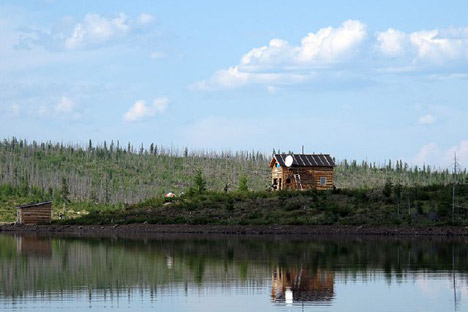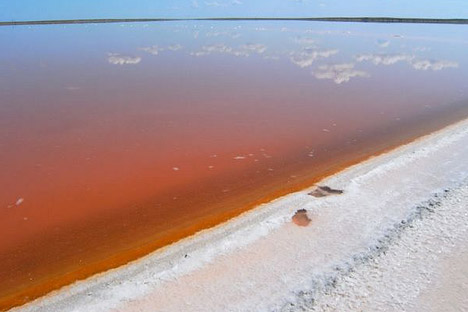The dive made by Dmitry Schiller’s team into the icy waters of Lake Labynkyr on February 1, 2013 could qualify for the Guinness World Records. The team members dived to the bottom of the polar lake at the coldest time of year, in Russia’s coldest region.
The dive has already prompted a blaze of publicity in the Russian media, not to mention the repercussions it has borne. Rumors abound that parts of the skeleton and jaws of a huge animal were found on the lakebed, with the help of camera technology.
The members of the Russian Geographical Society team have since denied this claim, but “Nessie Fever” was unstoppable. Both scientific and pseudo-scientific exploration teams have set off in pursuit of a Russian Loch Ness Monster all over the country.
Fans of paranormal events from RIR’s editorial team have tracked the movements of different expeditions and compiled a list of Russia’s more obscure lakes that might yet earn the title of “The Second Loch Ness.”
View ‘Loch Ness’ and other Russian water legends in a larger map
Nessie’s brother from Lake Labynkyr
Lake Labynkyr is located at an altitude of 1,020 meters (3,346 feet) above sea level, and its depth is 52.6 meters. The lakebed has an anomalous fissure, with a depth that reaches 75–80 meters.
Locals only ever refer to the lake as “The Second Loch Ness.” Viktor Tverdokhlebov, local lead researcher of a team from the East-Siberian Section of the Soviet Academy of Science, recorded in his notes a sighting of an unidentified animal floating on the lake’s surface and resembling a giant fish.
The dive made by Schiller’s team into the waters of Lake Labynkyr. Source: Russia Today
“It was moving in an arc, at first along the lake, and then it came toward us... a dark-grey, oval-shaped body moved across the water. Against this background could be made out two symmetrical white spots, which could be eyes, and standing up on its body was something like a stick — perhaps a fin.
We only saw a small part of this animal, but we could imagine there was a massive body in the water. It was undoubtedly a predator — one of the most powerful predators in the world,” wrote Tverdokhlebov.

Lake Labynkyr. Open Source
Very possibly, this report by a respected scientist has made the Lake Labynkyr Monster one of the more serious contenders for the role of a Second Nessie, even though the Russian Geographical Society (RGS) has rejected media reports of an alleged large animal jawbone located on the bed of the lake.
The giant bull-pike of Lake Khaiyr (Pestsovoye)
With its own “Valley Of Death” and flying saucers, Yakutia is a paradise for fans of the paranormal.
Not far from Astrakhan are the so-called “Raspberry Lakes.” They are noticeable not only for their color, but also for their distinct raspberry-like scent.
This was one reason why salt extracted from the lakes in hundreds of tons each year was considered the best in the land and delivered to the table of Russian Empress Catherine the Great.
This salt retains a pale pink color, along with the faint tang of raspberries. The color and aroma of salt in these waters are due to tiny crustaceans called “Artemia.” When they die and decompose, they give a unique fragrance to the salt water. These crustaceans are a favorite item in the diet of flamingos.
Yakutia has not just one alleged Loch Ness Monster, but two. According to witnesses, Lake Khaiyr, which is located above the Arctic Circle, is home to an unknown animal of monstrous proportions. The animal’s description corresponds closely to the Lake Labynkyr monster.
A 1964 expedition from Lomonosov Moscow State University’s North-Eastern Research Department, led by G. Rukosuev, recorded that a mysterious animal with a long snake-like neck lives in Khaiyr.
A member of a biological expedition team from the Yakutsk Division of the Russian Academy of Sciences, Nikolai Gladikh, left a written record.
“At 7 a.m. I went to the lake to get water, with a bucket. I couldn’t have gone more than 15 or 20 meters when I heard some kind of splash and saw a huge animal crawling out of the water. It was probably 4 to 4.5 meters [13-14 feet] long, 1.5 to 2 meters tall, with a long neck, maybe 1.5 meters. It had a small, flat head, like a snake,” reads Gladikh’s record.
After talking with locals, a team of researchers was able to gauge that the beast at the center of these stories is generally called the “Bull-Pike.” Despite the fact that the animal’s described appearance is cartoonish, it has not deterred scientific researchers from looking into the case.
The Brosno Dragon
The Russian Ogopogo — a mythical animal known only from reported sightings — lives in Lake Brosno, located in Tver Region. There have been no scientifically confirmed sightings of the beast, but legend would have us believe this is another Nessie.
As the story goes, the Brosno Dragon is a large, lizard-like plesiosaur — an object of fascination for many crypto-zoologists all over the world.
Credence for the legend of these lake lizards is strengthened by the lake’s unusual depth: at 41 meters (134.5 feet) it is the deepest lake in the Tver Region. The decaying detritus on the lakebed, which causes bubbles of hydrogen sulphide to rise to the surface, also adds eerie believability to the story. From a distance, the bubbles give the impression of something moving in the middle of the lake.

Raspberry Lake. Open source
Prehistoric animals in Elgygytyn Lake
Elgygytyn Lake is found 500 kilometers (310 miles) to the northwest of Anadyr, which is the capital city of Chukhotka — the farthest-flung region of Siberia. The lake area measures 120 square kilometers (46 square miles), and its depth in some places reaches 170 meters (557 feet).
Analysis of sediment at the bottom puts the lake’s age at 3.5 million years old. Despite its extreme northern location, the lake has never been covered in glaciers — suggesting the presence of some unknown, primordial, life traces in its waters.
Of course, local people have come up with a number of legends of the existence of a “great beast” living in Elgygytyn Lake.
The formation of Elgygytyn Lake is something of a mystery itself. It is perfectly circular in shape, and American scientific journals have speculated that it was formed by a falling meteorite. Alternative theories have posited that the lake basin might be the crater of an extinct volcano.
Homes, churches, bell towers and more, on the bed of Lake Svetloyar

Ivan Kupala celebration on lake Svetloyar. Source: Itar-Tass
Lake Svetloyar is a small lake in the forests of Nizhny Novgorod Region, just 12 square kilometers in size (4.6 square miles). In terms of its makeup, it closely resembles other lakes formed 12,000–14,000 years ago at the end of the Ice Age.
Lake Svetloyar is one of Russia’s most mysterious lakes. Nothing is normal about it — from the unusual water, the pure taste of which remains unchanged over long years, to the peculiar legend of the city of Kitezh, which mysteriously sank underwater when the Tatar–Mongol army of Batu Khan came to besiege its walls.
Geologists cannot agree on Lake Svetloyar’s origins, despite research that has dragged on for half a century. Some claim it formed on karst systems, which would be a blow to the idea of a city of Kitezh that voluntarily submerged beneath the waters.
Still others claim the lake is formed of solid rock, which is typical for the western part of Russia. Yet this rock structure is lined with faults, and Lake Svetloyar lies at the intersection of two such faults. This would mean that islands, which hypothetically stood in the lake, could indeed be submerged below the water in one of the faults. One such island might have been the site of the legendary city of Kitezh.
All rights reserved by Rossiyskaya Gazeta.